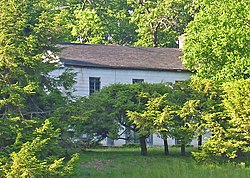West Point Foundry
|
West Point Foundry
|
|

The house of William Kemble, one of the company's founders, seen from the parking lot of the Cold Spring Metro-North station
|
|
| Location | Foundry Cove between NY 90 and NY Central RR tracks, Cold Spring, NY |
|---|---|
| Nearest city | Beacon |
| Coordinates | 41°24′51″N 73°57′22″W / 41.41417°N 73.95611°WCoordinates: 41°24′51″N 73°57′22″W / 41.41417°N 73.95611°W |
| Area | 93 acres (38 ha) |
| NRHP Reference # | 73001250 |
| Added to NRHP | April 11, 1973 |
|
West Point Foundry Archeological Site
|
|
| Location | Address Restricted, Cold Spring, New York |
|---|---|
| Area | 100 acres (40 ha) |
| Built | 1817 |
| NRHP Reference # | 10000059 |
| Added to NRHP | February 25, 2010 |
The West Point Foundry was an early ironworks in Cold Spring, New York that operated from 1817 to 1911. Set up to remedy deficiencies in national armaments production after the War of 1812, it became most famous for its production of Parrott rifle artillery and other munitions during the Civil War, although it also manufactured a variety of iron products for civilian use. The rise of steel making and declining demand for cast iron after the Civil War caused it to gradually sink into bankruptcy and cease operations in the early 20th Century.
The impetus for its creation came from James Madison, who, after the War of 1812, wanted to establish domestic foundries to produce artillery. Cold Spring was an ideal site: timber for charcoal was abundant, there were many local iron mines, and the nearby Margaret's Brook provided water power to drive machinery. The site was guarded by West Point, across the Hudson River, and the river provided shipping for finished products.
The West Point Foundry Association was incorporated by Gouverneur Kemble, who came from a merchant family in New York City (although his mother's family had connections in Putnam Co.), and the foundry began operation in 1817. Artillery was tested by firing across the Hudson at the desolate slopes of Storm King Mountain, which would later have to be swept for unexploded ordnance as a result after some of it exploded in a 1999 fire. The platform used for mounting artillery for proofing was uncovered during Superfund work in the early 1990s. Besides artillery, the foundry also produced iron fittings for civilian uses, such as pipe for the New York City water system and sugar mills for shipment to the West Indies. A number of early locomotives were built at the foundry, including the Best Friend of Charleston, the West Point, the DeWitt Clinton, Phoenix, and Experiment.
...
Wikipedia


